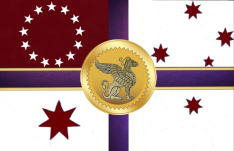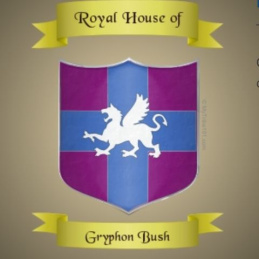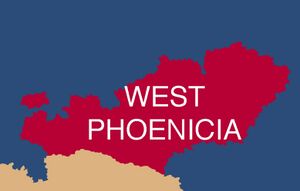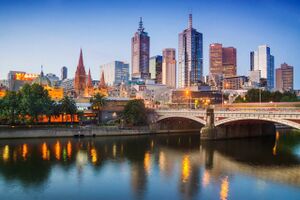User:West Phoenicia
The Confederate Empire of West Phoenicia | |
|---|---|
Anthem: "West Phoenicia in our hearts!" | |
| Capital and largest city | Melbourne-Haven |
| Official languages | English, West Phoenician |
| Demonym(s) | West Phoenician |
| Government | Confederate Constitutional Monarchy |
• Monarch | Emperor Glenton Gryphon-Bush II |
• Prime Minister | Countess Tia High |
• Deputy Prime Minister | Aaron Airè |
• Speaker of the House | Honourable Brad Atin |
| Legislature | Parliament |
| Senate | |
| House of Representatives | |
| Population | |
• 2019 estimate | 100 million |
| Currency | The Ba'al |
The Confederate Empire of West Phoenicia commonly called West Phoenicia, is a Confederate Parliamentary Constitutional Monarchy where the royal family hold almost deity-like status.
To the South is the Theocracy of Annixe Christos and The Great Empire of Eldrado.
To the north lies the Federal Republic of Alenberg and The Federated Principality of Fluvannia.
And to the north and the west the Republic of Bayerland
To the North-West lies the nations of Tesyky and People's Republic of Vyeborg
West Phoenicia covers 783,356 km2 square kilometers and has has an estimated population of 100 million. West Phoenicia comprises of 53 city-states and a handful of external territories. Each of those city-states are broken down into a number of provinces/districts.
History
The Confederate Empire of West Phoenicia has a rich vibrant history. From there initial struggles to becoming a new nation. West Phoenicians pride themselves on their history.
It is a history filled with wars and civil wars, of throne disputes as siblings often married to each other fought for the privilege to wear the crown of West Phoenicia.
It is a history of love and honour weaved together with betrayel, deceit and envy.
See: History of The Confederate Empire of West Phoenicia.
Geography
West Phoenicia comprisies of 53 city states, external territories and large islands off the mainland. It is located on the Galia continent.
Each city-state has their own unique identity and culture while at the same time encompassing all the virtues, traditions and laws of West Phoenicia.
West Phoenicia is surrounded by various oceans; with the Achrinian Ocean to the north and the Rochian Ocean to the south.
West Phoenicia has rich fertile land in the north, south and east of the nation which is used for the growing of tobacco, cotton, coffee and tea; major sources of West Phoenician exports.
Gold, silver, emerald and sapphire mines are located in the western regions of the nation along with the nations main oil fields.
Melbourne-Haven; the West Phoenician capital is located on the east coast. A thriving metropolis of large man made lakes, towering skylines, fancy boutiques, the largest zoo in West Phoenicia and is also the prime centre of government, trade and commerce.
The western coast city-states have humid subtropical climates, with the exception of some of the higher elevations in the Mt Ethabaal mountain ranges of Upper West Phoenicia.
While the northern and eastern regions are classified as having a mountain temperate climate or a humid continental climate due to cooler temperatures.
The east and south east city-states have a more temperate climate with large amounts of rainfall especially in Winter and Spring.
Generally West Phoenicia has mild to hot summers and cold winters with some city-states reporting large snow falls.
Summers in West Phoenicia are generally hot and humid, with most of the city-states averaging a high of around 30 degrees during the summer months.
Winters tend to be mild to very cool especially on the east coast, increasing in coolness at higher elevations. Generally, for areas outside the highest mountains, the average overnight lows are near freezing for most of the state. East coast city-states tend to have high annual rain fall between April to September.
Royal Family
The Bush Family is the Royal Family of West Phoenicia that has ruled The Confederate Empire of West Phoenicia since 1616.
Glenton Bush I was a member of the nobility who over threw the House of Dorcas which had ruled West Phoenicia since 1586. After overthrowing the previous royal family Glenton Bush I was crowned king and began the Bush Dynasty.
Politics and Government
Foreign Relations
Military
Economy
Industry
Infrastructure
Energy
West Phoencia's major utilities include a collection of brown-coal-fired power stations located in the western regions to supply energy to the north, east and west regions of West Phoencia's.
While in the Southern regions of West Phoenicia, alternative energy schemes such as wind and solar power are implemented to reduce the carbon emission and reliance on brown coal.
Water
West Phoenician water infrastructure includes a series of dams and reservoirs, predominantly in Central West Phoenicia that hold and collect water for much of the nation. The water collected is of a very high quality and requires little chlorination treatment, giving the water a pristine pure taste. In regional areas however, such as in the western regions, chlorination levels are much higher.The West Phoencia Water Grid consists of a number of new connections and pipelines being built across the nation. This allows water to be moved around West Phoencia to where it is needed most and reduces the impact of localized droughts in an era thought to be influenced by climate change. In New Rome and New Egypt vast mega modern aqueducts also exists to assist in non city areas
Transport
The West Phoenician road network services the population centres, with highways radiating from Melbourne-Haven to all major cities and rural centres with secondary roads interconnecting the highways to each other.
Public Transport All populated capital cities and outlining suburbs have an extensive train, trams and bus services run by private operators. Train and tram services in all major cities are run 24 hours a day.
Rural areas are connected by public and private bus services and run 24 hours a day.
Airlines
There are many airports around West Phoenicia paved or unpaved. The number of airports stands at 180.
The busiest airports in West Phoenicia are:
- Melbourne-Haven International- Jackson
- Melbourne-Haven Domestic - Jackson
- Olympia Hills Airport
- Agape Faith Airport
- Olympia Hills Domestic
- Nova Texas Regional Airport
Airline Providers:
- West Phoenicia Air is the main airline servicing both International and Domestic travel.



